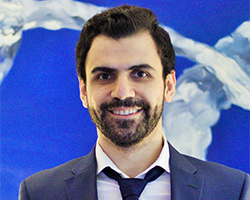Team continues photoacoustic, ultrasound technique for ovarian cancer diagnosis
The work addresses the urgent need for early detection of ovarian cancer

Ovarian cancer is the deadliest of all cancers affecting the female reproductive system, creating an urgent need to develop new tools for early detection.
A multidisciplinary team at Washington University in St. Louis is fine-tuning a tool that uses photoacoustic tomography and ultrasound to measure hemoglobin and blood oxygen saturation that has shown improved accuracy in diagnosis. Both the growth of new blood vessels as well as tumor oxygenation are related to tumor growth, metabolism and therapeutic response. The results of the work are published as the inside cover story in the April 2021 issue of the Journal of Biophotonics.
In previous research, published in 2018, the team found that photoacoustic tomography provided researchers with a very detailed look at the tumor's vasculature, or tumor angiogenesis, and blood oxygen saturation (sO2) by lighting up the tumor's vasculature bed and allowing for more accurate diagnoses of ovarian masses seen by ultrasound. Since then, the team has acquired more patient data, fine-tuning the imaging tool on hardware, algorithms and data processing.
In the new study, the team took images with its co-registered photoacoustic tomography and ultrasound system of from 33 patients with 51 ovarian masses. The images were divided into four groups: invasive epithelial ovarian cancer; other neoplasm; benign ovaries; and normal ovaries. An attending radiologist evaluated all available images for each patient, which included X-ray CT and prior ultrasound, then provided a score for each mass from 1 to 5: 1 and 2 were normal; 3 is likely benign; 4 is suspicious for malignancy; and 5 is highly suspicious for malignancy. This ranking detected most malignant ovaries, but misclassified several benign ovaries as malignant. The area under the receiving characteristic curve (AUC) achieved 0.85. With the addition of tumor vascular and sO2 parameters from photoacoustic imaging, the overall diagnosis achieved AUC of 0.93.
Eghbal Amidi, a biomedical engineering doctoral student in the lab of Quing Zhu, professor of biomedical engineering in the McKelvey School of Engineering and of radiology in the School of Medicine, said the improved photoacoustic imaging algorithm generated a robust sO2 map that allows them to reliably extract more features that, combined with the radiologists’ diagnostic score, significantly improved accuracy of diagnosis.
Results of the study, which are the first to show that blood oxygen plays a major role in the diagnosis of ovarian cancer, are a significant step toward the clinical translation of the technology.
The team is conducting a larger clinical study by collaborating with Cary Siegel, MD, professor of radiology; Matthew Powell, MD, chief of the Division of Gynecologic Oncology and professor of obstetrics and gynecology; and other physicians in the departments of Radiology and of Obstetrics & Gynecology at the School of Medicine to validate the initial results.
Amidi E, Yang G, Shihab Uddin KM, Luo H, Middleton W, Powell M, Siegel C, Zhu Q. Role of blood oxygenation saturation in ovarian cancer diagnosis using multi-spectral photoacoustic tomography. Journal of Biophotonics, April 2021, Vol. 14, Issue 4. Published online April 12, 2010. https://doi.org/10.1002/jbio.202170012
This research was supported by the National Cancer Institute (R01CA151570 and R01CA237664).





